mybatis
环境:
jdk1.8
mysql5.7
maven3.6.1
IDEA
回顾
jdbc
mysql
java基础
maven
junit
MySql8.0及以上对应的应用程序数据库链接驱动包要更新为8.0版本,否则会报驱动异常。
jdbc.driver=com.mysql.cj.jdbc.Driver
jdbc:mysql://localhost:3306/mybatis?serverTimezone=UTC&useUnicode=true&characterEncoding=utf8&autoReconnect=true&useSSL=false
- 在xml里“&”用”&“来替换
- 时区用UTC,需要大写
SSM框架:配置文件的
https://mybatis.org/mybatis-3/zh/index.html
1、简介
1.1什么是Mybatis
MyBatis 是一款优秀的持久层框架,它支持自定义 SQL、存储过程以及高级映射。
MyBatis 免除了几乎所有的 JDBC 代码以及设置参数和获取结果集的工作。
MyBatis 可以通过简单的 XML 或注解来配置和映射原始类型、接口和 Java POJO(Plain Old Java Objects,普通老式 Java 对象)为数据库中的记录。
怎么获取mybatis
maven
<!-- https://mvnrepository.com/artifact/org.mybatis/mybatis -->
<dependency>
<groupId>org.mybatis</groupId>
<artifactId>mybatis</artifactId>
<version>3.5.3</version>
</dependency>
GitHub:
中文文档: https://mybatis.org/mybatis-3/zh/index.html
1.2持久化
数据持久化
- 持久化就是将程序的数据在持久状态和瞬时状态转化的过程
- 内存:断电即失
- 数据库(jdbc),io文件持久化
- 生活:冷藏、罐头
为什么需要持久化?
- 有一些对象,不能让他丢掉。
- 内存太贵了
1.3持久层
Dao层、Service层、Controller层…
- 完全持久化工作的代码块
- 层界限十分明显
1.4为什么需要Mybatis
- 方便
- 传统的jdbc代码太复杂。简化。框架。
- 帮程序员将数据存入到数据库
- 这句话是废话,就不记了
2、第一个Mybatis程序
思路:搭建环境–>导入Mybatis–>编写代码–>测试
2.1搭建环境
创建数据库
use mybatis;
INSERT INTO `user`(id,name,pwd) VALUES
(1,'鲁班','1234567'),
(2,'孙尚香','2345678'),
(3,'达摩','9876554');
1、新建一个普通的maven项目
2、删除src目录
3、导入maven依赖
<?xml version="1.0" encoding="UTF-8"?>
<project xmlns="http://maven.apache.org/POM/4.0.0"
xmlns:xsi="http://www.w3.org/2001/XMLSchema-instance"
xsi:schemaLocation="http://maven.apache.org/POM/4.0.0 http://maven.apache.org/xsd/maven-4.0.0.xsd">
<modelVersion>4.0.0</modelVersion>
<!---父工程-->
<groupId>org.example</groupId>
<artifactId>MyBatisStudy</artifactId>
<version>1.0-SNAPSHOT</version>
<!--导入依赖-->
<dependencies>
<!--mysql驱动-->
<dependency>
<groupId>mysql</groupId>
<artifactId>mysql-connector-java</artifactId>
<version>5.1.41</version>
</dependency>
<!--mybatis-->
<!-- https://mvnrepository.com/artifact/org.mybatis/mybatis -->
<dependency>
<groupId>org.mybatis</groupId>
<artifactId>mybatis</artifactId>
<version>3.5.3</version>
</dependency>
<!--junit-->
<dependency>
<groupId>junit</groupId>
<artifactId>junit</artifactId>
<version>4.12</version>
<scope>test</scope>
</dependency>
</dependencies>
</project>
2.2创建一个模块
- 编写mybatis的核心配置文件
<?xml version="1.0" encoding="UTF-8" ?>
<!DOCTYPE configuration
PUBLIC "-//mybatis.org//DTD Config 3.0//EN"
"http://mybatis.org/dtd/mybatis-3-config.dtd">
<configuration>
<environments default="development">
<environment id="development">
<transactionManager type="JDBC"/>
<dataSource type="POOLED">
<property name="driver" value="com.mysql.cj.jdbc.Driver"/>
<property name="url" value="jdbc:mysql://localhost:3306/mybatis?useSSL=true&useUnicode=true&characterEncoding=UTF-8&serverTimezone=UTC"/>
<property name="username" value="root"/>
<property name="password" value="123456"/>
</dataSource>
</environment>
</environments>
<mappers>
<mapper resource="org/mybatis/example/BlogMapper.xml"/>
</mappers>
</configuration>
- 编写mybatis工具类
package com.mydatis.utils;
import org.apache.ibatis.io.Resources;
import org.apache.ibatis.session.SqlSession;
import org.apache.ibatis.session.SqlSessionFactory;
import org.apache.ibatis.session.SqlSessionFactoryBuilder;
import java.io.IOException;
import java.io.InputStream;
//sqlSessionFactory-->sqlSession
public class MybatisUtils {
private static SqlSessionFactory sqlSessionFactory;
static {
try {
//使用Mybatis第一步:获取SQLSessionFactory对象
String resource="mybatis-config.xml";
InputStream inputStream = Resources.getResourceAsStream(resource);
sqlSessionFactory = new SqlSessionFactoryBuilder().build(inputStream);
} catch (IOException e) {
e.printStackTrace();
}
}
//既然有了 SqlSessionFactory,顾名思义,我们可以从中获得 SqlSession 的实例。
// SqlSession 提供了在数据库执行 SQL 命令所需的所有方法。
public static SqlSession getSqlSession(){
return sqlSessionFactory.openSession();
}
}
2.3编写代码
- 实体类
package com.mydatis.pojo;
public class User {
private int id;
private String name;
private String pwd;
public User() {
}
public User(int id, String name, String pwd) {
this.id = id;
this.name = name;
this.pwd = pwd;
}
public int getId() {
return id;
}
public void setId(int id) {
this.id = id;
}
public String getName() {
return name;
}
public void setName(String name) {
this.name = name;
}
public String getPwd() {
return pwd;
}
public void setPwd(String pwd) {
this.pwd = pwd;
}
}
- Dao接口
package com.mydatis.dao;
import com.mydatis.pojo.User;
import java.util.List;
public interface UserDao {
List<User> getUserList();
}
- 接口实体类由原来的UserDaoImpl转换为一个Mapper配置文件
<?xml version="1.0" encoding="UTF-8" ?>
<!DOCTYPE mapper
PUBLIC "-//mybatis.org//DTD Mapper 3.0//EN"
"http://mybatis.org/dtd/mybatis-3-mapper.dtd">
<!--namespace=绑定一个对应的Dao/Mapper接口-->
<mapper namespace="com.mydatis.dao.UserDao">
<select id="getUserList" resultType="com.mydatis.pojo.User">
select * from mybatis.user;
</select>
</mapper>
2.4测试
注意点:
org.apache.ibatis.binding.BindingException: Type interface com.mydatis.dao.UserDao is not known to the MapperRegistry.
MapperRegistry是什么?
核心配置文件中注册mappers
测试代码:
package com.mybatis.dao;
import com.mydatis.dao.UserDao;
import com.mydatis.pojo.User;
import com.mydatis.utils.MybatisUtils;
import org.apache.ibatis.session.SqlSession;
import org.junit.Test;
import java.util.List;
public class UserDaoTest {
@Test
public void test1(){
//第一步获取sqlsession对象
SqlSession sqlSession = MybatisUtils.getSqlSession();
//方式一:getMapper
UserDao userDao = sqlSession.getMapper(UserDao.class);
List<User> userList = userDao.getUserList();
for (User user : userList) {
System.out.println("user = " + user);
}
//关闭SQLSession
sqlSession.close();
}
}
可能遇到的问题
1、配置文件没有注册
2、绑定接口错误
3、方法名不对
4、返回类型不对
5、Maven导出资源问题
<!--在build中配置resources,来防止我们资源导出失败的问题-->
<build>
<resources>
<resource>
<directory>src/main/resources</directory>
<includes>
<include>**/*.properties</include>
<include>**/*.xml</include>
</includes>
<filtering>true</filtering>
</resource>
<resource>
<directory>src/main/java</directory>
<includes>
<include>**/*.properties</include>
<include>**/*.xml</include>
</includes>
<filtering>true</filtering>
</resource>
</resources>
</build>
3、CRUD
1、namespace
namespace对应的Dao/Mapper接口报名一致
2、select
选择、查询语句
- id:就是对应namespace的方法名
- resultType:SQL语句执行的返回值
- parameterType:参数类型
1、编写接口
//根据id查询用户
User getUserById(int id);
2、编写对应的的Mapper中的sql语句
<select id="getUserById" parameterType="int" resultType="com.mydatis.pojo.User">
select * from mybatis.user where id = #{id};
</select>
3、测试
@Test
public void test2(){
SqlSession sqlSession = MybatisUtils.getSqlSession();
UserMapper mapper = sqlSession.getMapper(UserMapper.class);
User user = mapper.getUserById(2);
System.out.println("user = " + user);
}
3、insert
<!--对象中的属性,可以直接取出来-->
<insert id="addUser" parameterType="com.mydatis.pojo.User">
insert into mybatis.user (id,name,pwd) values (#{id},#{name},#{pwd});
</insert>
4、update
<update id="updateUser" parameterType="com.mydatis.pojo.User" >
update mybatis.user set name = #{name} , pwd=#{pwd} where id=#{id};
</update>
5、delete
<delete id="deleteUser" parameterType="int">
delete from mybatis.user where id =#{id};
</delete>
6、分析错误
- 标签不要错
- resource绑定Mapper,需要使用路径
- 程序配置文件必须符合规范!
7、万能的map
假设,我们的实体类,或者数据库中的表,字段或者参数过多,我们应该考虑使用Map
//insert一个用户
int addUser2(Map<String,Object> map);
<insert id="addUser2" parameterType="map">
insert into mybatis.user (id,name,pwd) values (#{userid},#{username},#{userpwd});
</insert>
public void test6(){
SqlSession sqlSession = MybatisUtils.getSqlSession();
UserMapper mapper = sqlSession.getMapper(UserMapper.class);
Map<String, Object> map = new HashMap<String, Object>();
map.put("userid",4);
map.put("username","露娜");
map.put("userpwd","2346567");
mapper.addUser2(map);
sqlSession.commit();
sqlSession.close();
}
Map传递参数,直接在sql中取key即可 【parameterType=“map”】
对象传递参数,直接在sql中取对象的属性即可 【parameterType=“com.mydatis.pojo.User”】
只有一个基本类型参数的情况下,可以直接在sql中取到,可以不用写【parameterType=“int”】
多个参数用Map,或者是注解
8、思考题
模糊查询怎么写
1、java代码执行的时候,传递通配符% %
List<User> userLike = mapper.getUserLike("鲁");
2、在sql拼接的时候,使用通配符
select * from mybatis.user where name like "%" #{value} "%";
4、配置解析
1、核心配置文件
- mybatis-config.xml
- MyBatis 的配置文件包含了会深深影响 MyBatis 行为的设置和属性信息
configuration(配置)
properties(属性)
settings(设置)
typeAliases(类型别名)
typeHandlers(类型处理器)
objectFactory(对象工厂)
plugins(插件)
environments(环境配置)
environment(环境变量)
transactionManager(事务管理器)
dataSource(数据源)
databaseIdProvider(数据库厂商标识)
mappers(映射器)
2、环境配置(environments)
MyBatis 可以配置成适应多种环境
不过要记住:尽管可以配置多个环境,但每个 SqlSessionFactory 实例只能选择一种环境。
学会使用多套运行环境
mybatis默认事务管理是jdbc 连接池:pooled
3、属性(properties)
我们可以通过properties 属性引用外部配置文件
这些属性可以在外部进行配置,并可以进行动态替换。你既可以在典型的 Java 属性文件中配置这些属性,也可以在 properties 元素的子元素中设置

编写一个配置文件
db.properties
driver=com.mysql.cj.jdbc.Driver
url=jdbc:mysql://localhost:3306/mybatis?serverTimezone=UTC&useUnicode=true&characterEncoding=utf8&autoReconnect=true&useSSL=false
username=root
password=123456
在配置文件中映入
<properties resource="db.properties">
<property name="username" value="root"/>
<property name="password" value="123456"/>
</properties>
可以直接引入外部文件
可以在其中增加一些属性配置
如果有两个文件同一字段,优先使用配置文件
4、类型别名(typeAliases)
- 类型别名可为 Java 类型设置一个缩写名字。
- 它仅用于 XML 配置,意在降低冗余的全限定类名书写
<!--可以给实体类起别名-->
<typeAliases>
<typeAlias type="com.mydatis.pojo.User" alias="User"/>
</typeAliases>
也可以指定一个包名,MyBatis 会在包名下面搜索需要的 Java Bean 比如:
扫描实体类的包,默认别名就是为这个类的类名,首字母小写;
<!--可以给实体类起别名-->
<typeAliases>
<package name="com.mydatis.pojo"/>
</typeAliases>
在实体类少的时候可以用第一种
在实体类多的是时候可以用第二种
第一种可以自定义别名,第二种不可以自定义别名,但是可以通过注解的方式来定义别名
通过注解的方式来定义别名,必须添加扫描实体类的包
5、设置(settings)
- 这是 MyBatis 中极为重要的调整设置,它们会改变 MyBatis 的运行时行为。



6、其他配置
- typeHandlers(类型处理器)
- objectFactory(对象工厂)
- plugins(插件)
- mybatis-generator-core
- mybatis-plus
- 通用mapper
7、映射器(mappers)
MapperRegistry:注册绑定我们的Mapper文件
方式一:【推荐使用】
<mappers>
<mapper resource="com/mydatis/dao/UserMapper.xml"/>
</mappers>
方式二:使用class文件绑定注册
<mappers>
<mapper class="com.mydatis.dao.UserMapper"/>
</mappers>
注意:
-
接口文件和他Mapper配置文件必须同名
-
接口文件和他Mapper配置文件必须在一个包下
方式三:使用扫描包进行注入绑定
<mappers>
<package name="com.mydatis.dao"/>
</mappers>
注意:
-
接口文件和他Mapper配置文件必须同名
-
接口文件和他Mapper配置文件必须在一个包下
8、作用域(Scope)和生命周期
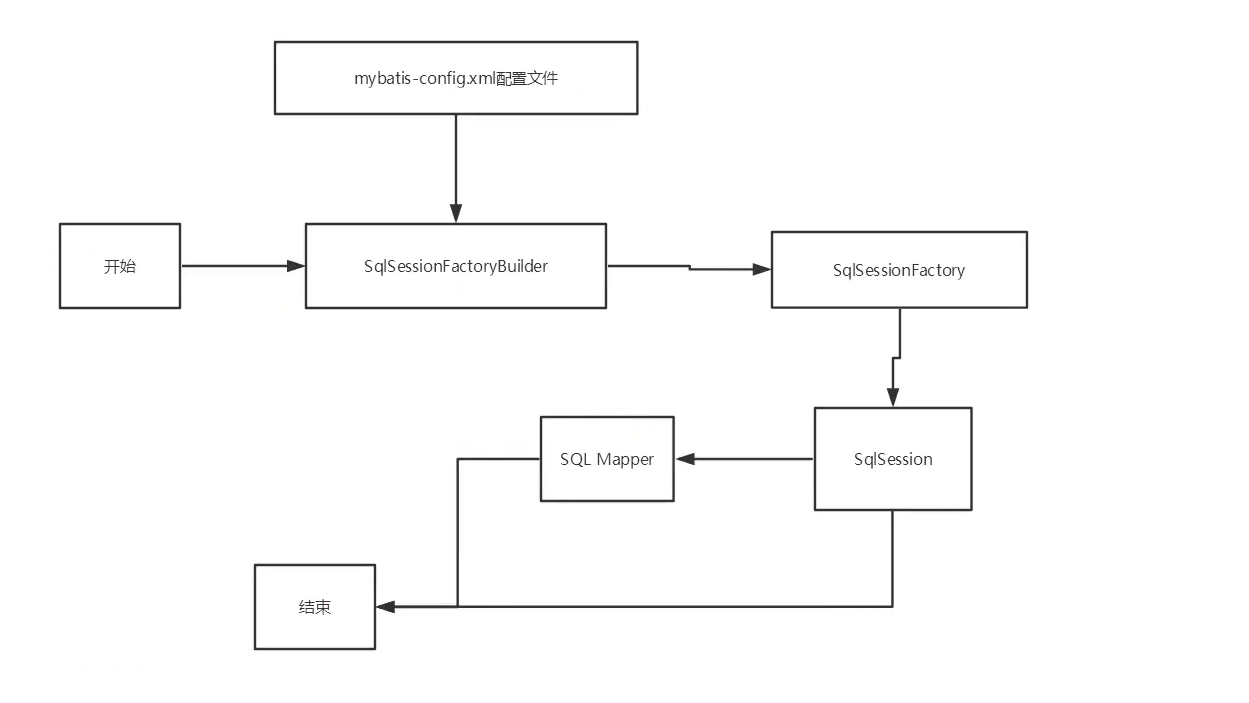
生命周期和作用域是至关重要的,因为错误的使用会导致非常严重的并发问题。
SqlSessionFactoryBuilder:
- 一旦创建了 SqlSessionFactory,就不再需要它了
- 局部变量
SqlSessionFactory:
-
说白了就是可以想象为:数据库连接池
-
SqlSessionFactory 一旦被创建就应该在应用的运行期间一直存在,没有任何理由丢弃它或重新创建另一个实例。
-
SqlSessionFactory 的最佳作用域是应用作用域。
-
有很多方法可以做到,最简单的就是使用单例模式或者静态单例模式。
SqlSession:
- 连接到连接池的一个请求
- SqlSession 的实例不是线程安全的,因此是不能被共享的,所以它的最佳的作用域是请求或方法作用域。
- 用完之后赶紧关掉,否则资源占用
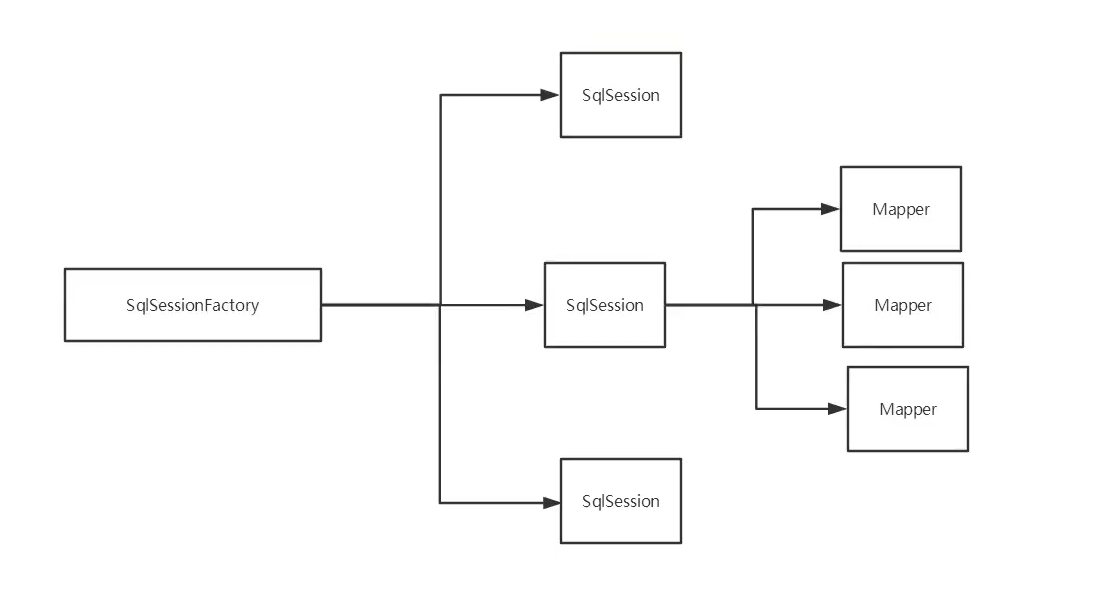
这里面每个Mapper,就代表一个具体的业务。
5、解决属性名和字段名不一致的问题
数据库中的字段

实体类字段
public class User1 {
private int id;
private String name;
private String password;
}
测试出现的问题:

问题原因:
select * from mybatis.user;
select id,name,pwd from mybatis.user;
解决方法:
- 起别名
<select id="getUserList" resultType="com.mydatis.pojo.User1">
select id,name,pwd as password from mybatis.user;
</select>
- resultMap
结果集映射
id name pwd
id name password
<resultMap id="userMap" type="com.mydatis.pojo.User1">
<result column="id" property="id"/>
<result column="name" property="name"/>
<result column="pwd" property="password"/>
</resultMap>
<select id="getUserLike" resultType="com.mydatis.pojo.User">
select * from mybatis.user where name like #{value} ;
</select>
resultMap元素是 MyBatis 中最重要最强大的元素。- ResultMap 的设计思想是,对简单的语句做到零配置,对于复杂一点的语句,只需要描述语句之间的关系就行了。
- 这就是
ResultMap的优秀之处——你完全可以不用显式地配置它们。
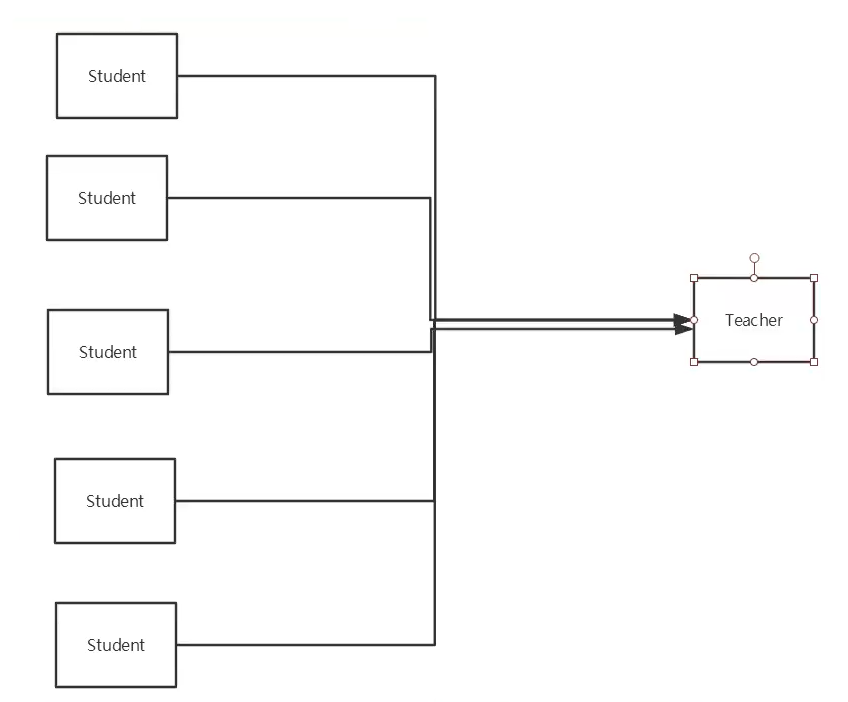
6、日志
6.1日志工程
如果一个数据库操作,出现了异常,我们需要排错。日志就是最好的助手!
曾经:sout、debug
现在:日志工厂

- SLF4J
- LOG4J 【掌握】
- LOG4J2
- JDK_LOGGING
- COMMONS_LOGGING
- STDOUT_LOGGING 【掌握】
- NO_LOGGING
在Mybatis中具体使用哪一个日志实现,在设置中设定
STDOUT_LOGGING标准日志输出
<settings>
<setting name="logImpl" value="STDOUT_LOGGING"/>
</settings>

6.2log4j
什么是log4j?
- Log4j是Apache的一个开源项目,通过使用Log4j,我们可以控制日志信息输送的目的地是控制台、文件、GUI组件,甚至是套接口服务器、NT的事件记录器、UNIX Syslog守护进程等;
- 我们也可以控制每一条日志的输出格式;
- 通过定义每一条日志信息的级别,我们能够更加细致地控制日志的生成过程。
- 最令人感兴趣的就是,这些可以通过一个配置文件来灵活地进行配置,而不需要修改应用的代码。
1、先导入log4j的包
<!-- https://mvnrepository.com/artifact/log4j/log4j -->
<dependency>
<groupId>log4j</groupId>
<artifactId>log4j</artifactId>
<version>1.2.17</version>
</dependency>
2、log4j.properties
#将等级为DEBUG的日志信息输出到console和file这两个目的地,console和file的定义在下面的代码
log4j.rootLogger=DEBUG,console,file
#控制台输出的相关设置
log4j.appender.console = org.apache.log4j.ConsoleAppender
log4j.appender.console.Target = System.out
log4j.appender.console.Threshold=DEBUG
log4j.appender.console.layout = org.apache.log4j.PatternLayout
log4j.appender.console.layout.ConversionPattern=[%c]-%m%n
#文件输出的相关设置
log4j.appender.file = org.apache.log4j.RollingFileAppender
log4j.appender.file.File=./log/kuang.log
log4j.appender.file.MaxFileSize=10mb
log4j.appender.file.Threshold=DEBUG
log4j.appender.file.layout=org.apache.log4j.PatternLayout
log4j.appender.file.layout.ConversionPattern=[%p][%d{yy-MM-dd}][%c]%m%n
#日志输出级别
log4j.logger.org.mybatis=DEBUG
log4j.logger.java.sql=DEBUG
log4j.logger.java.sql.Statement=DEBUG
log4j.logger.java.sql.ResultSet=DEBUG
log4j.logger.java.sql.PreparedStatement=DEBUG
3、配置log4j为日志的实现
<settings>
<setting name="logImpl" value=""/>
</settings>
4、运行测试的代码

简单使用
1、在要使用log4j 的类中,导入包import org.apache.log4j.Logger;
2、日志对象,参数为类的class
Logger logger = Logger.getLogger(UserDaoTest.class);
3、日志级别
logger.info("进入Testlog4j");
logger.debug("进入Testlog4j");
logger.error("进入Testlog4j");
7、分页
思考:为什么要分页
- 减少数据的处理量
7.1、使用Limit分页
语法:select * from user limit startIndex,pageSize;
select * from user limit 3; #{0,n}
使用Mybatis实现分页,核心sql
1、接口
//分页
List<User> getUserByLimit(Map<String,Object> map);
2、Mapper.xml
<select id="getUserByLimit" resultType="user">
select * from user limit #{startIndex},#{pageSize};
</select>
3、测试
@Test
public void test9(){
SqlSession sqlSession = MybatisUtils.getSqlSession();
UserMapper mapper = sqlSession.getMapper(UserMapper.class);
Map<String, Object> map = new HashMap<>();
map.put("startIndex",2);
map.put("pageSize",2);
List<User> userByLimit = mapper.getUserByLimit(map);
for (User user : userByLimit) {
System.out.println("user = " + user);
}
}
7.2、RowBounds分页
不在使用sql实现分页
1、接口
//分页
List<User> getUserByRowBounds();
2、mapper.xml
<select id="getUserByRowBounds" resultType="user">
select * from user ;
</select>
3、测试
SqlSession sqlSession = MybatisUtils.getSqlSession();
RowBounds rowBounds = new RowBounds(1,2);
//通过Java代码层面实现分页
List<User> user = sqlSession.selectList("com.mydatis.dao.UserMapper.getUserByRowBounds", null, rowBounds);
for (User user1 : user) {
System.out.println("user1 = " + user1);
}
}
7.3分页插件
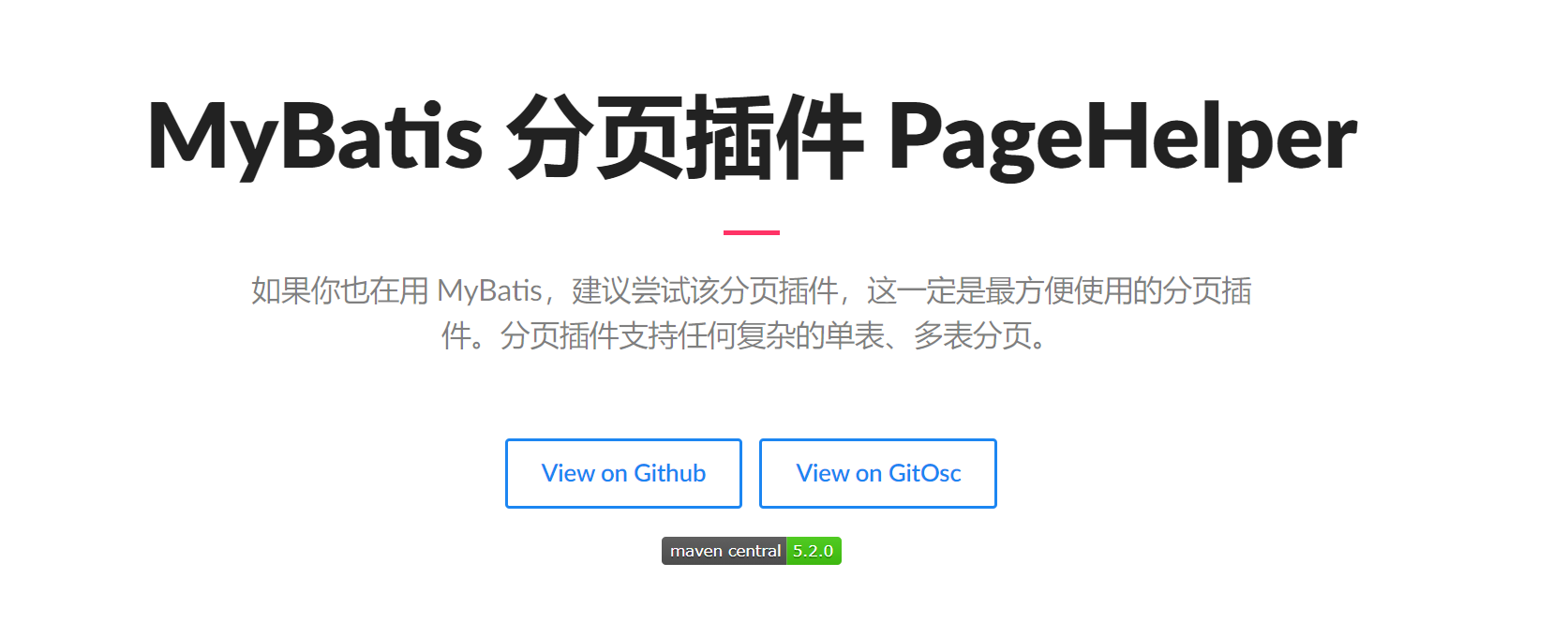
了解即可
8、使用注解开发
8.1面向接口编程
大家之前都学过面向对象编程,也学习过接口,但在真正的开发中,很多时候我们会选择面向接口编程
根本原因:解耦,可拓展,提高复用,分层开发中,上层不用管具体的实现,大家都遵守共同的标准,使得
开发变得容易,规范性更好
在一个面向对象的系统中,系统的各种功能是由许许多多的不同对象协作完成的。在这种情况下,各个对象内部
是如何实现自己的,对系统设计人员来讲就不那么重要了;
•而各个对象之间的协作关系则成为系统设计的关键。小到不同类之间的通信,大到各模块之间的交互,在系统设
计之初都是要着重考虑的,这也是系统设计的主要工作内容。面向接口编程是指按照这种思想来编程。
关于接口的理解
-接口从更深层次的理解,应是定义(规范,约束)与实现(名实分离的原则)的分离。
-接口的本身反映了系统设计人员对系统的抽象理解。
-接口应有两类:
-第一类是对一个个体的抽象,它可对应为一个抽象体(abstract class);
-第二类是对一个个体某一方面的抽象,即形成一个抽象面(interface);
-一个有可能有多个抽象面。抽象体与抽象面是有区别的。
三个面向区别
-面向对象是指,我们考虑问题时,以对象为单位,考虑它的属性及方法.
-面向过程是指,我们考虑问题时,以一个具体的流程(事务过程)为单位,考虑它的实现.
-接口设计与非接口设计是针对复用技术而言的,与面向对象(过程)不是一个问题.更多的体现就是对系统整体的架构
8.2使用注解开发
1、注解在接口上实现
@Select("select * from user")
List<User> getUsers();
2、需要在核心配置文件中绑定接口
<mappers>
<mapper class="com.mydatis.dao.UserMapper"/>
</mappers>
3、测试
本质:反射机制实现
底层:动态代理
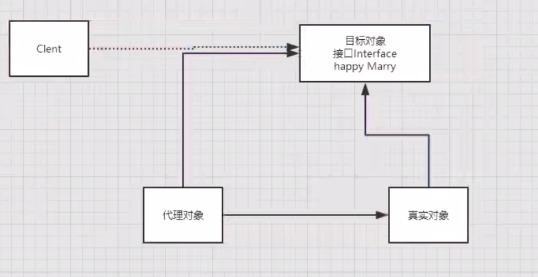
Mybatis详细执行流程

8.3CRUD
我们可以在创建工具类的时候实现自动提交事务!
public static SqlSession getSqlSession(){
return sqlSessionFactory.openSession(true);
}
编写接口,增加注解
@Select("select * from user")
List<User> getUser();
@Insert("insert into user(id,name,pwd) values(#{id},#{name},#{pwd})")
int addUser(User user);
@Update("update user set name=#{name} ,pwd=#{pwd} where id=#{id}")
int updateUser(User user);
//方法存在多个参数,所有的参数前面都要必须加上@Param("id")注解
@Delete("delete from user where id = #{id1}")
int deleteUser(@Param("id1") int id);
测试类
【注意:我们必须要讲接口注册绑定到我们核心配置文件中】
关于@Param()注解
- 基本类型的参数或者String类型,需要加上
- 引用类型不需要加
- 如果只要一个基本类型的话,可以忽略,但建议大家都加上!
- 我们在SQL中引用的就是我们这里的@Param中设定的属性名
#{}和${}的区别
- ${}:sql拼接符号(替换结果不会增加单引号‘’,like和order by后使用,存在sql注入问题,需手动代码中过滤)
- #{}:占位符号,可以防止sql注入(替换结果会增加单引号‘’)
9、lombok
Project Lombok is a java library that automatically plugs into your editor and build tools, spicing up your java.
Never write another getter or equals method again, with one annotation your class has a fully featured builder, Automate your logging variables, and much more
- java library
- plugs
- build tools
- with one annotation your class
使用步骤:
1、在idea中安装lombok插件
@Getter and @Setter
@FieldNameConstants
@ToString
@EqualsAndHashCode
@AllArgsConstructor, @RequiredArgsConstructor and @NoArgsConstructor
@Log, @Log4j, @Log4j2, @Slf4j, @XSlf4j, @CommonsLog, @JBossLog, @Flogger, @CustomLog
@Data
@Builder
@SuperBuilder
@Singular
@Delegate
@Value
@Accessors
@Wither
@With
@SneakyThrows
@val
@var
experimental @var
@UtilityClass
Lombok config system
Code inspections
Refactoring actions (lombok and delombok)
2、在项目中导入lombok的jar
<!-- https://mvnrepository.com/artifact/org.projectlombok/lombok -->
<dependency>
<groupId>org.projectlombok</groupId>
<artifactId>lombok</artifactId>
<version>1.18.12</version>
</dependency>
3、在实体类上加注解
@Data
@AllArgsConstructor
@NoArgsConstructor
注意:
@Data 无参构造器 get set tostring hashcode
@AllArgsConstructor
@NoArgsConstructor
10、多对一处理
多对一
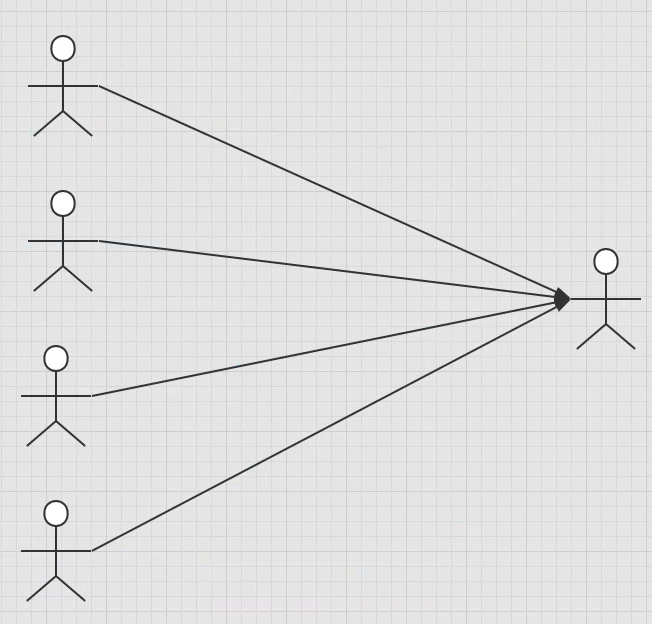
多个学生对应一个老师
对应学生而言,关联 多个学生关联一个老师【多对一】
对于老师而言,集合 一个老师有多个学生【一对多】
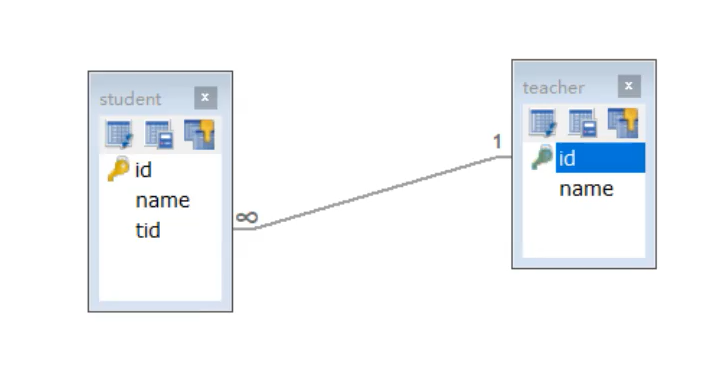
SQL:
CREATE TABLE `teacher` (
`id` INT(10) NOT NULL,
`name` VARCHAR(30) DEFAULT NULL,
PRIMARY KEY (`id`)
) ENGINE=INNODB DEFAULT CHARSET=utf8
INSERT INTO teacher(`id`, `name`) VALUES (1, '秦老师');
CREATE TABLE `student` (
`id` INT(10) NOT NULL,
`name` VARCHAR(30) DEFAULT NULL,
`tid` INT(10) DEFAULT NULL,
PRIMARY KEY (`id`),
KEY `fktid` (`tid`),
CONSTRAINT `fktid` FOREIGN KEY (`tid`) REFERENCES `teacher` (`id`)
) ENGINE=INNODB DEFAULT CHARSET=utf8
INSERT INTO `student` (`id`, `name`, `tid`) VALUES ('1', '小明', '1');
INSERT INTO `student` (`id`, `name`, `tid`) VALUES ('2', '小红', '1');
INSERT INTO `student` (`id`, `name`, `tid`) VALUES ('3', '小张', '1');
INSERT INTO `student` (`id`, `name`, `tid`) VALUES ('4', '小李', '1');
INSERT INTO `student` (`id`, `name`, `tid`) VALUES ('5', '小王', '1');
测试环境搭建
1、导入lombok
2、新建实体类student,teacher
3、新建Mapper接口
4、新建Mapper.xml
5、在核心配置文件中绑定Mapper接口或文件
6、测试查询是否成功
按照查询嵌套处理
<!--查询所有的学生信息
根据查询出来的学生tid,寻找对于的老师 子查询
-->
<select id="getStudent" resultMap="StudentTeacher">
select * from student
</select>
<resultMap id="StudentTeacher" type="com.mybatis.pojo.Student">
<result property="id" column="id"/>
<result property="name" column="name"/>
<association property="teacher" column="tid" javaType="com.mybatis.pojo.Teacher" select="getTeacher"/>
</resultMap>
<select id="getTeacher" resultType="com.mybatis.pojo.Teacher">
select * from teacher where id=#{id}
</select>
按照结果嵌套处理
<select id="getStudent1" resultMap="StudentTeacher">
select s.id sid,s.name sname,t.name tname from student s ,teacher t where s.tid=t.id
</select>
<resultMap id="StudentTeacher" type="com.mybatis.pojo.Student">
<result property="id" column="sid"/>
<result property="name" column="sname"/>
<association property="teacher" javaType="com.mybatis.pojo.Teacher">
<result property="name" column="tname"/>
</association>
</resultMap>
回顾Mysql多对一方式
- 子查询
- 联表查询
11、一对多处理
按照结果嵌套处理
<select id="getTeacher" resultMap="TeacherStudent">
select t.id id,t.name name,s.id sid,s.name sname,s.tid stid from teacher t,student s where s.tid=t.id and t.id=#{tid};
</select>
<resultMap id="TeacherStudent" type="com.mybatis.pojo.Teacher">
<result property="id" column="id"/>
<result property="name" column="name"/>
<collection property="students" ofType="com.mybatis.pojo.Student">
<result property="id" column="sid"/>
<result property="name" column="sname"/>
<result property="tid" column="stid"/>
</collection>
</resultMap>
按照查询嵌套处理
<select id="getTeacher2" resultMap="TeacherStudent2">
select * from teacher where id =#{tid};
</select>
<resultMap id="TeacherStudent2" type="com.mybatis.pojo.Teacher">
<collection property="students" javaType="ArrayList" ofType="com.mybatis.pojo.Student" select="stuid" column="id"/>
</resultMap>
<select id="stuid" resultType="com.mybatis.pojo.Student">
select * from student where tid=#{tid}
</select>
小结
1、关联-association 适用于多对一
2、集合-collection 适用于一对多
3、JavaType 和 ofType
1、javaType 用来指定实体类中属性的类型
2、ofType用来指定映射到List或者中pojo类型,泛型中的约束类型!
注意点:
注意一对多和多对一中,属性名和字段的问题
面试高频:
- MySQL引擎
- InnoDB底层原理
- 索引
- 索引优化
12、动态sql
什么是动态sql:动态sql就是根据不同的条件生成不同的sql语句
利用动态 SQL,可以彻底摆脱这种痛苦。
- if
- choose (when, otherwise)
- trim (where, set)
- foreach
搭建环境
sql语句
CREATE TABLE `blog`(
`id` VARCHAR(50) NOT NULL COMMENT '博客id',
`title` VARCHAR(100) NOT NULL COMMENT '博客标题',
`author` VARCHAR(30) NOT NULL COMMENT '博客作者',
`create_time` DATETIME NOT NULL COMMENT '创建时间',
`views` INT(30) NOT NULL COMMENT '浏览量'
)ENGINE=INNODB DEFAULT CHARSET=utf8
创建一个基础工程
1、导包
2、编写配置文件
3、编写实体类
@Data
public class Blog {
private String id;
private String title;
private String author;
private Date createTime;
private int views;
}
4、编写实体类对应的Mapper接口和Mapper.xml文件
IF
<select id="queryBlogIf" parameterType="map" resultType="com.mybatis.pojo.Blog">
select * from Blog where 1=1
<if test="title!=null">
and title=#{title}
</if>
<if test="author!=null">
and author=#{author}
</if>
</select>
choose (when, otherwise)
<select id="queryBlogChoose" parameterType="map" resultType="com.mybatis.pojo.Blog">
select * from Blog
<where>
<choose>
<when test="title!=null">
and title=#{title}
</when>
<when test="author!=null">
and author=#{author}
</when>
<otherwise>
and views=#{views}
</otherwise>
</choose>
</where>
</select>
trim (where, set)
<update id="updateBlog" parameterType="map">
update Blog
<set>
<if test="title!=null">
title=#{title},
</if>
<if test="author!=null">
author=#{author}
</if>
</set>
where id=#{id}
</update>
所谓的动态sql,本质还是sql语句,只是我们在SQL执行一个逻辑代码
sql片段
有时候,我们可能会将一些功能的部分抽取出来,方便复用!
1、在使用SQL标签提出公共的部分
<sql id="sql1">
<choose>
<when test="title!=null">
and title=#{title}
</when>
<when test="author!=null">
and author=#{author}
</when>
<otherwise>
and views=#{views}
</otherwise>
</choose>
</sql>
2、在需要使用的地方用include标签引用即可
<select id="queryBlogChoose" parameterType="map" resultType="com.mybatis.pojo.Blog">
select * from Blog
<where>
<include refid="sql1"></include>
</where>
</select>
注意事项:
- 最好基于单表来定义SQL片段
- 不要存在where标签
Foreach
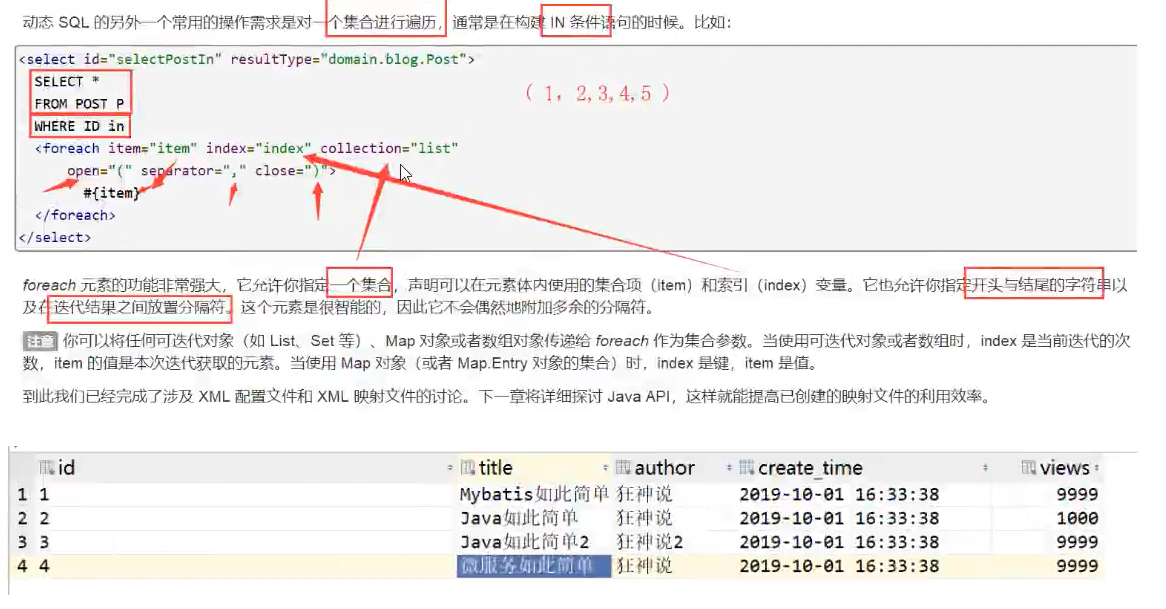
<select id="queryBlogForeach" parameterType="map" resultType="com.mybatis.pojo.Blog">
select * from Blog
<where>
<foreach collection="ids" item="id" open="(" close=")" separator="or">
id=#{id}
</foreach>
</where>
</select>
13、缓存
缓存简介
1.什么是缓存[ Cache ]?
存在内存中的临时数据。
将用户经常查询的数据放在缓存(内存)中,用户去查询数据就不用从磁盘上(关系型数据库数据文件)查询,从缓存中查询,从而提高查询效率,解决了高并发系统的性能问题。
2.为什么使用缓存?
减少和数据库的交互次数。减少系统开销,提高系统效率。3.什么样的数据能使用缓存?
经常查询并且不经常改变的数据。
Mybatis缓存
MyBatis包含一个非常强大的查询缓存特性,它可以非常方便地定制和配置缓存。缓存可以极大的提升查询效率。
MyBatis系统中默认定义了两级缓存:一级缓存和二级缓存
默认情况下,只有一级缓存开启。(SqlSession级别的缓存,也称为本地缓存)。二级缓存需要手动开启和配置,他是基于namespace级别的缓存。
为了提高扩展性,MyBatis定义了缓存接口Cache。我们可以通过实现Cache接口来自定义二级缓存
一级缓存
一级缓存也叫本地缓存:
与数据库同一次会话期间查询到的数据会放在本地缓存中。
以后如果需要获取相同的数据,直接从缓存中拿,没必须再去查询数据库;
一级缓存就是一个Map
二级缓存
二级缓存也叫全局缓存,一级缓存作用域太低了,所以诞生了二级缓存·基于namespace级别的缓存,一个名称空间,对应一个二级缓存;
工作机制
一个会话查询一条数据,这个数据就会被放在当前会话的一级缓存中;
如果当前会话关闭了,这个会话对应的一级缓存就没了;但是我们想要的是,会话关闭了,一级缓存中的数据被保存到二级缓存中;
新的会话查询信息。就可以从二级缓存中获取内容;
不同的mapper查出的数据会放在自己对应的缓存(map)中;
步骤:
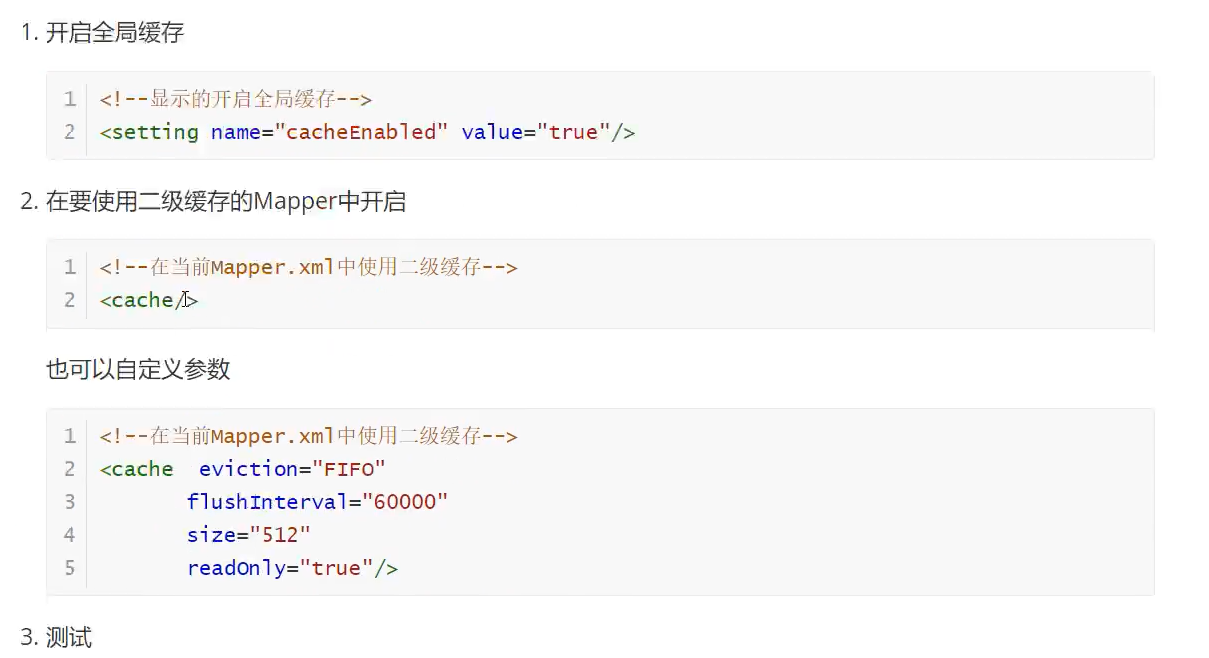

缓存原理
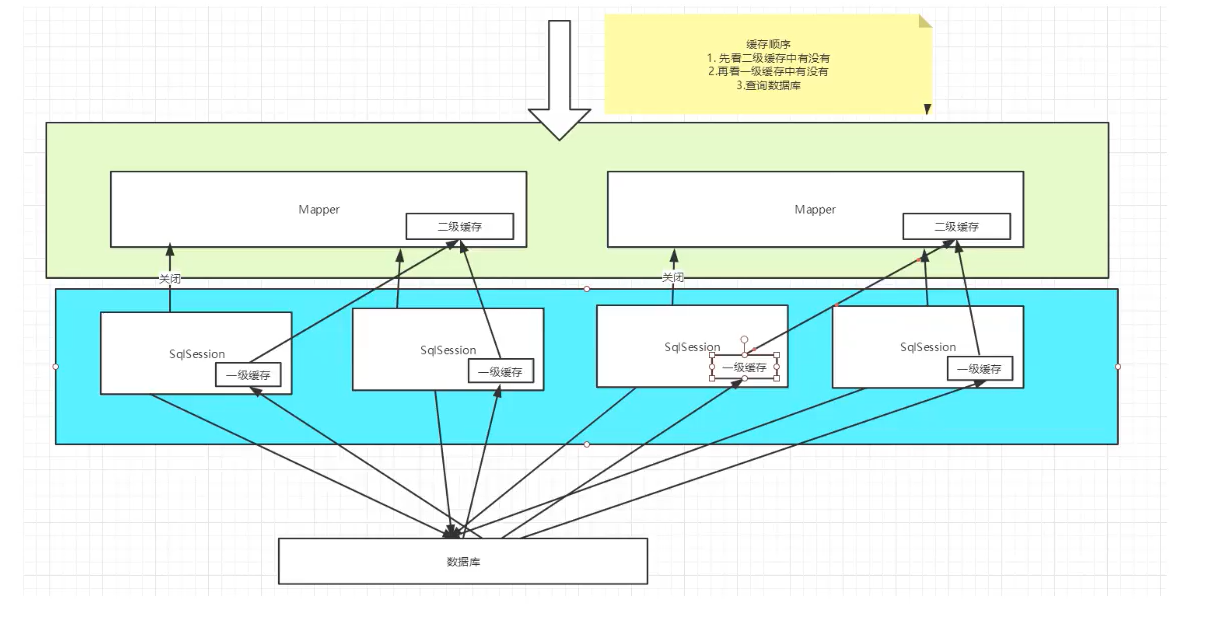
自定义缓存-ehcahe
pojo.Blog">
select * from Blog
注意事项:
- 最好基于单表来定义SQL片段
- 不要存在where标签
### Foreach
[外链图片转存中...(img-IPiWG720-1605175813447)]
```xml
<select id="queryBlogForeach" parameterType="map" resultType="com.mybatis.pojo.Blog">
select * from Blog
<where>
<foreach collection="ids" item="id" open="(" close=")" separator="or">
id=#{id}
</foreach>
</where>
</select>
13、缓存
缓存简介
1.什么是缓存[ Cache ]?
存在内存中的临时数据。
将用户经常查询的数据放在缓存(内存)中,用户去查询数据就不用从磁盘上(关系型数据库数据文件)查询,从缓存中查询,从而提高查询效率,解决了高并发系统的性能问题。
2.为什么使用缓存?
减少和数据库的交互次数。减少系统开销,提高系统效率。3.什么样的数据能使用缓存?
经常查询并且不经常改变的数据。
Mybatis缓存
MyBatis包含一个非常强大的查询缓存特性,它可以非常方便地定制和配置缓存。缓存可以极大的提升查询效率。
MyBatis系统中默认定义了两级缓存:一级缓存和二级缓存
默认情况下,只有一级缓存开启。(SqlSession级别的缓存,也称为本地缓存)。二级缓存需要手动开启和配置,他是基于namespace级别的缓存。
为了提高扩展性,MyBatis定义了缓存接口Cache。我们可以通过实现Cache接口来自定义二级缓存
一级缓存
一级缓存也叫本地缓存:
与数据库同一次会话期间查询到的数据会放在本地缓存中。
以后如果需要获取相同的数据,直接从缓存中拿,没必须再去查询数据库;
一级缓存就是一个Map
二级缓存
二级缓存也叫全局缓存,一级缓存作用域太低了,所以诞生了二级缓存·基于namespace级别的缓存,一个名称空间,对应一个二级缓存;
工作机制
一个会话查询一条数据,这个数据就会被放在当前会话的一级缓存中;
如果当前会话关闭了,这个会话对应的一级缓存就没了;但是我们想要的是,会话关闭了,一级缓存中的数据被保存到二级缓存中;
新的会话查询信息。就可以从二级缓存中获取内容;
不同的mapper查出的数据会放在自己对应的缓存(map)中;
步骤:


缓存原理

自定义缓存-ehcahe
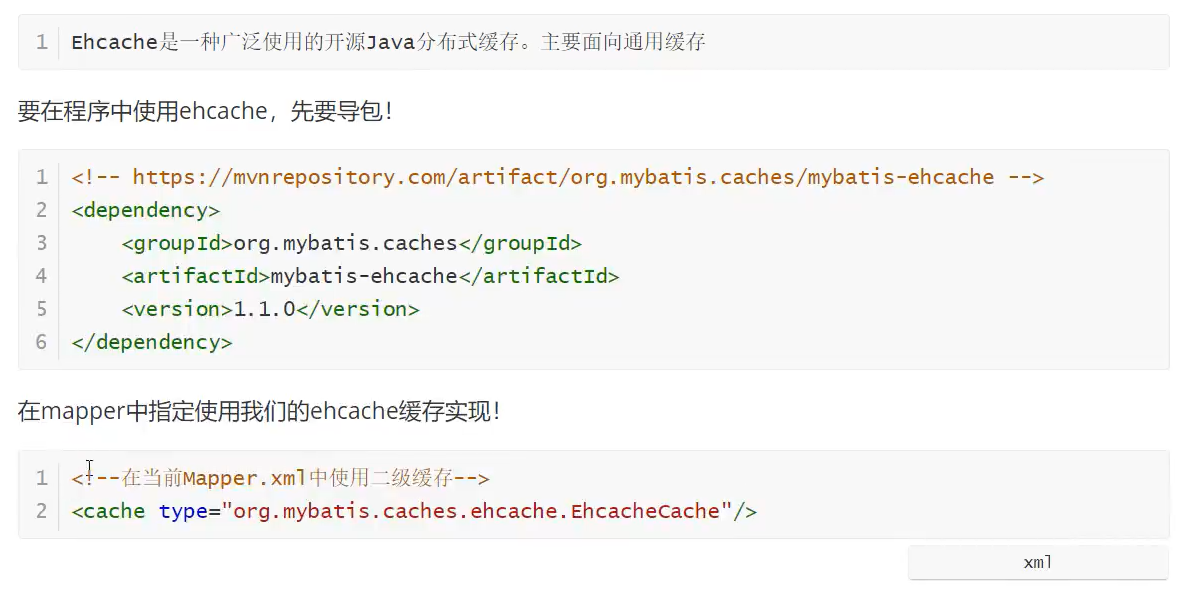






















 2128
2128











 被折叠的 条评论
为什么被折叠?
被折叠的 条评论
为什么被折叠?








